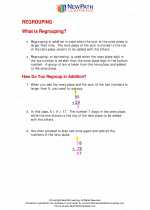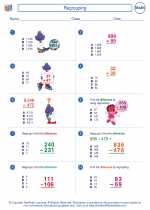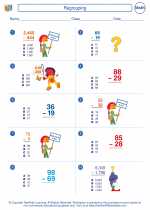Regrouping in Addition and Subtraction
Regrouping, also known as borrowing or carrying, is a fundamental concept in addition and subtraction. It allows us to perform operations when the digits in one place value column add up to 10 or more, or when we need to subtract a larger digit from a smaller one.
Regrouping in Addition
When adding two multi-digit numbers, regrouping is necessary when the sum of the digits in a particular place value column exceeds 9. For example, when adding 47 and 68, we add the ones column first. 7 + 8 equals 15, which is more than 9. So, we regroup by carrying the tens place value, and write down the 5 in the ones place. The 1 is then carried over to the tens column. This process continues through each place value column until all digits have been added.
Regrouping in Subtraction
In subtraction, regrouping is required when the digit being subtracted is larger than the digit it is being subtracted from. For example, when subtracting 52 from 37, we start with the ones column. Since 7 is smaller than 2, we need to regroup from the tens column. We borrow 1 from the tens column, making it 2 tens and 7 ones. The borrowed ten is added to the ones column, giving us 17 - 2, which equals 15.
Understanding when and how to regroup is essential for mastering addition and subtraction of multi-digit numbers. It helps students develop a deeper understanding of place value and the base-ten system.
Practice and repetition are key to mastering regrouping, and there are many worksheets and online resources available for further practice.
[Regrouping] Related Worksheets and Study Guides:
.◂Math Worksheets and Study Guides Third Grade. Regrouping

 Worksheet/Answer key
Worksheet/Answer key
 Worksheet/Answer key
Worksheet/Answer key
 Worksheet/Answer key
Worksheet/Answer key
